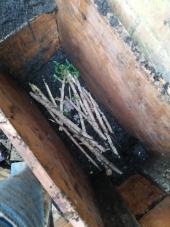


Rocket Mass Heater Plans: Annex 6" L-shaped Bench by Ernie and Erica
will be released to subscribers in:
soon!











 2
2












Buy Our Book! Food Web: Concept - Raising Food the Right Way. Learn make more food with less inputs
Off Grid Homesteading - latest updates and projects from our off grid homestead




 2
2




A human being should be able to change a diaper, plan an invasion, butcher a hog, conn a ship, design a building, write a sonnet, balance accounts, build a wall, set a bone, comfort the dying, take orders, give orders, cooperate, act alone, solve equations, analyze a new problem, pitch manure, program a computer, cook a tasty meal, fight efficiently, die gallantly. Specialization is for insects.
-Robert A. Heinlein




ediblecities Hatfield wrote:A neighbour had to put a fallen conifer down, I have no idea which. Can I use it to grow mushrooms on it? Which mushrooms?
Mushroomers Club
A place dedicated to mushroom lovers
Facebook Fan Page




Check out Redhawk's soil series: https://permies.com/wiki/redhawk-soil




John Saltveit wrote:There is a kind of oyster called the Phoenix oyster, also called Italian oyster- that grows well on Fir and SPruce.
John S
PDX OR
Buy Our Book! Food Web: Concept - Raising Food the Right Way. Learn make more food with less inputs
Off Grid Homesteading - latest updates and projects from our off grid homestead
 1
1




Check out Redhawk's soil series: https://permies.com/wiki/redhawk-soil








Check out Redhawk's soil series: https://permies.com/wiki/redhawk-soil








Check out Redhawk's soil series: https://permies.com/wiki/redhawk-soil




Buy Our Book! Food Web: Concept - Raising Food the Right Way. Learn make more food with less inputs
Off Grid Homesteading - latest updates and projects from our off grid homestead




Check out Redhawk's soil series: https://permies.com/wiki/redhawk-soil
 3
3




This is all just my opinion based on a flawed memory





Check out Redhawk's soil series: https://permies.com/wiki/redhawk-soil
 1
1








Check out Redhawk's soil series: https://permies.com/wiki/redhawk-soil




 1
1




 2
2





 1
1





- Tim's Homestead Journal - Purchase a copy of Building a Better World in Your Backyard - Purchase 6 Decks of Permaculture Cards -
- Purchase 12x Decks of Permaculture Cards - Purchase a copy of the SKIP Book - Purchase 12x copies of Building a Better World in your Backyard

|
Oh the stink of it! Smell my tiny ad!
Freaky Cheap Heat - 2 hour movie - HD streaming
https://permies.com/wiki/238453/Freaky-Cheap-Heat-hour-movie
|


